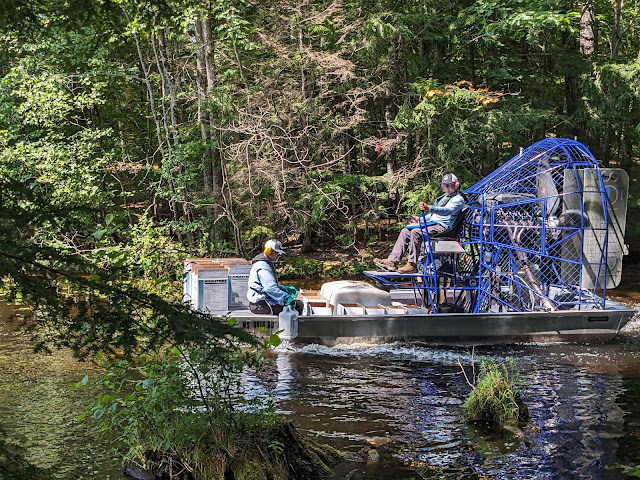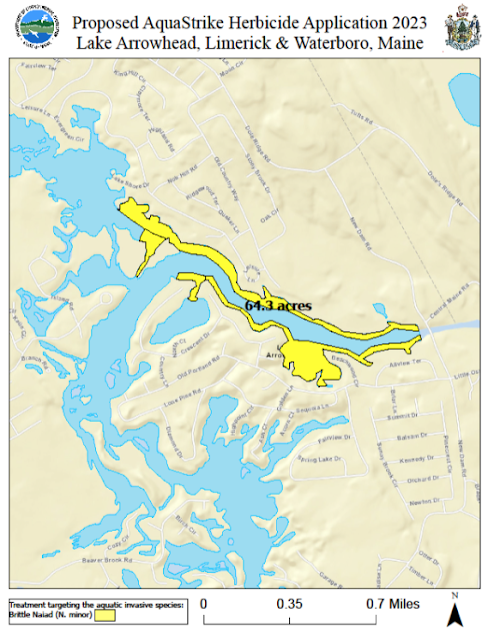Lake Arrowhead is known to have three invasive aquatic plants.
The battle against milfoil has been fought since about 2000, initially with manual removal of plants and then later with benthic barriers, and a suction harvester, and then with two suction harvesters, every summer. Milfoil is found throughout the lake. It cannot be eradicated through mechanical means (harvesting). Efforts are now aimed at trying to manage the plant.
Brittle Naiad is relatively new in the lake, having being discovered in 2020, and removed by hand in 2021 and 2022. Mechanical removal of plants is impractical. It only appears in significant numbers from July onwards and produces seeds by August. It is an annual and the plants disintegrate in the fall, spreading thousands of seeds for subsequent summers.
The Swollen Bladderwort discovered in 2021 is found throughout the lake, and the decision was made in 2022 not to attempt eradication.
The Maine Department of Environmental Protection (DEP) addresses invasive aquatic plants in Maine waters through prevention, early detection and control. The funding comes from the milfoil sticker program. The DEP has been funding programs on Lake Arrowhead for many years, but it has become clear that their tool of last resort, herbicide, would be needed urgently if there is any hope of eradicating Brittle Naiad. As part of the DEP rapid response to new infestations, they have decided to apply herbicide in 2023 to part of the lake where the Naiad is most prevalent. Their primary focus is the Brittle Naiad, but since they would need to go through all the permitting to apply a herbicide, it was decided to also target the milfoil in the same area, at the same time, at their expense.
Maine has a strong policy of only using herbicides as a last resort. This differs to neighboring states that use herbicides extensively.
In May, the DEP sent letters to lakefront property owners explaining the plan and announced a public meeting at the LAC clubhouse on June 15, 2023. The information was also posted on social media in order to inform as much of the public as possible.
The herbicides are registered by the EPA and Board of Pesticide control. They ensure that there are no unreasonable adverse effects on humans, the environment and non-target species. Herbicides have been used on a few lakes in Maine including Pickerel Pond in Limerick.
Here are the (updated as of 2023-07-20) major points of the plan:
- The treatment area will be in two parts from the Brown Brook feed to the dam:
- Targeting Milfoil only from Brown brook inlet almost to the confluence, using a product called ProcellaCOR (August) Paid for by LACC.
- Targeting Naiad and Milfoil as shown on the map below, using a product called Aquastrike, a combination of Diquat and Endothall. (Completed July 20, 2023) Paid for by DEP. See DEP notice letter.

The DEP contracted Solitude to apply Aquastrike on July 20, 2023 - The second date is still being coordinated with the company that is licensed to apply it.
- DEP will perform surveys before and after the applications to monitor effects on other plants.
- After application, water tests will be performed until the herbicide can no longer be detected.
- Tests will also be performed on the LAC well water.
- Advisories will be posted, for example:
- Not to drink lake water for 3 days
- Not to let livestock consume lake water for 1 day
- Not to irrigate turf and landscape ornamentals for 3 days
- Not to irrigate food crops for 5 days
- There is no limitation on swimming or fishing but the DEP suggests not swimming on the day of application.
- Some native aquatic plants are expected to suffer some collateral damage, but they typically bounce back rapidly.
- There is no known toxicity to fish.
- Additional applications will be assessed year to year, and applications are expected in subsequent years.
